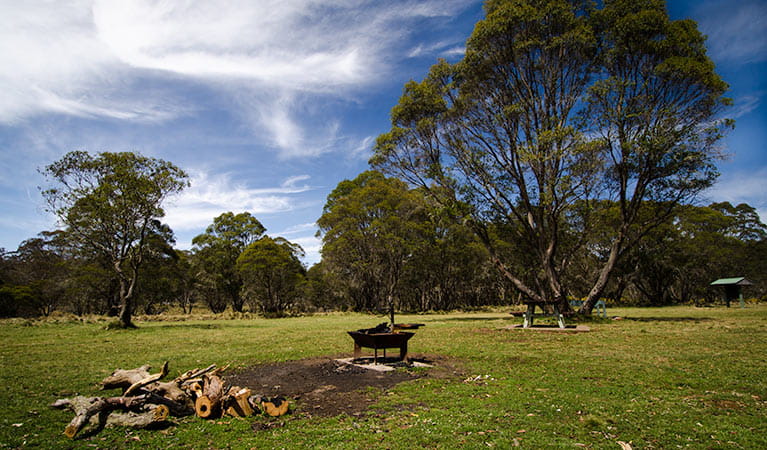Little Murray campground
Barrington Tops National Park
Overview
The remote Little Murray campground offers walking, mountain biking, fishing, and 4WD touring in the wilderness of Barrington Tops National Park, 3 hours from Newcastle.
| Number of campsites | 8 |
|---|---|
| Camping type | Tent, Camper trailer site, Camping beside my vehicle |
| Facilities | Picnic tables, barbecue facilities, carpark, toilets |
| What to bring | Firewood |
| Group bookings | Bookings for up to 5 sites and 20 people can be made online. School groups and commercial tour operators can submit a group booking enquiry form. |
| Please note |
|
When it’s time to head for the hills, why not go all the way to the plateau country of Barrington Tops National Park? This remote campground offers a unique wilderness getaway accessed via 4WD. Although only three hours from Newcastle, you'll be waking here to a dawn chorus of birdsong.
Set up your campsite before exploring the magnificent high country. The swamps of the plateau region have been declared an endangered ecological community as there are numerous rare and unique species that call this area home, such as the broad-toothed rat. However, you’re more likely to see flame robins and Richards pipets among the trees, and grazing red-necked wallabies.
Walk or cycle to spectacular Careys Peak lookout or plan your bushwalk via Link trail – Gloucester Tops to Careys Peak. If your style is more leisurely, try your hand at fishing and cook up your catch over a campfire.
Take a virtual tour of Little Murray campground captured with Google Street View Trekker.
Also see
-

Barrington trail
Take the challenge of the Barrington trail, a 4WD trail in Barrington Tops National Park. Open between October and May every year, plan your 4WD camping holiday now.
Map
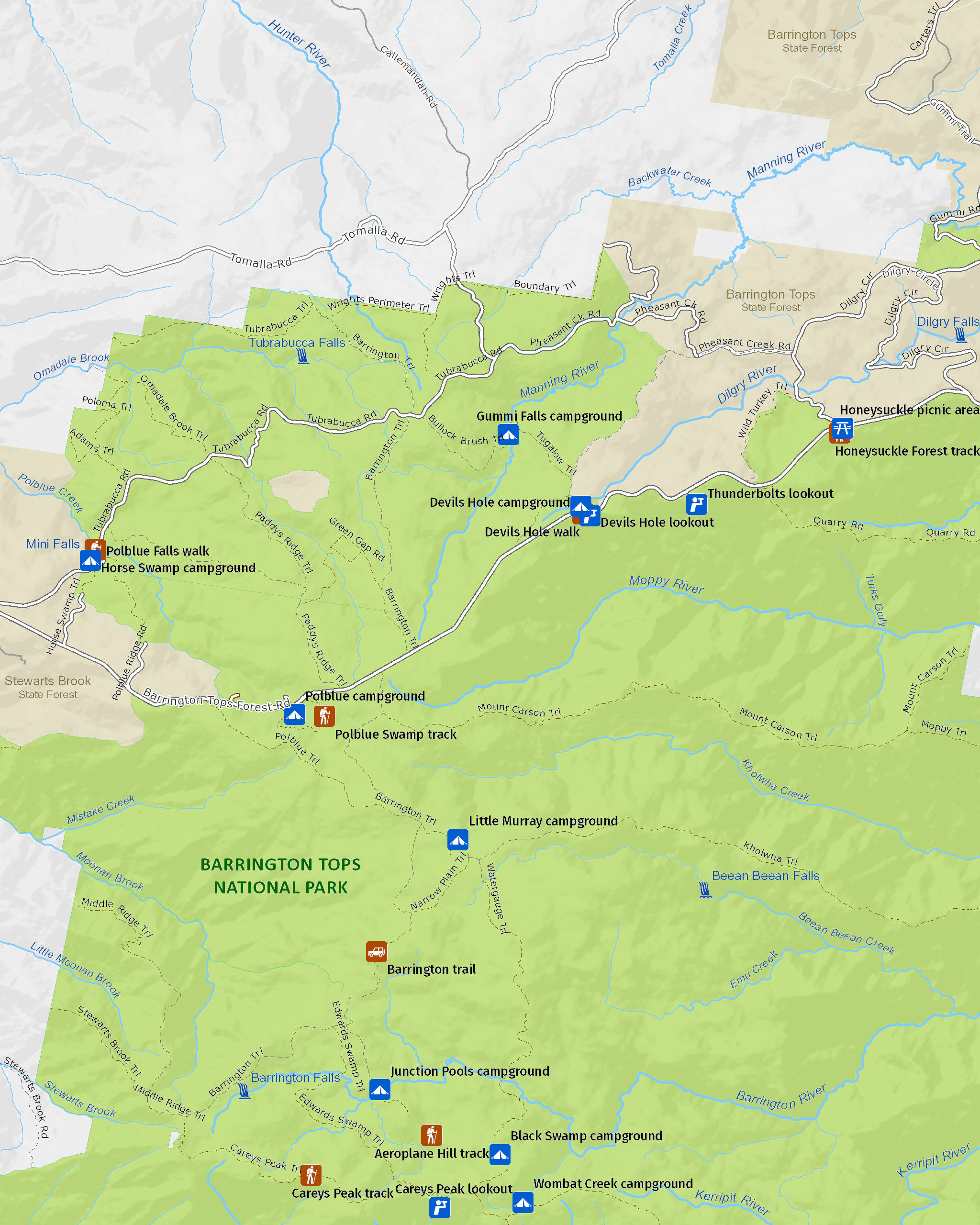
Map legend

Local alerts
For the latest updates on fires, closures and other alerts in this area, see https://www.nationalparks.nsw.gov.au/camping-and-accommodation/campgrounds/little-murray-campground/local-alerts
Bookings
- National Parks Contact Centre
- 7am to 7pm daily
- 1300 072 757 (13000 PARKS) for the cost of a local call within Australia excluding mobiles
- parks.info@environment.nsw.gov.au
Operated by
- Gloucester office
- Monday to Friday, 8.30am to 4.30pm.
- 02 6538 5300
- npws.barringtontops@environment.nsw.gov.au
- 59 Church Street, Gloucester NSW 2422
Park info
- in Barrington Tops National Park in the North Coast and Country NSW regions
Barrington Tops National Park is always open but may have to close at times due to poor weather or fire danger.
Visitor info
All the practical information you need to know about Little Murray campground.
Getting there and parking
Little Murray campground is in the Barrington Tops precinct of Barrington Tops National Park.
From Gloucester:
- Take Thunderbolts Way; this road becomes Scone Road and Barrington Tops Forest Road.
- Turn left into Barrington trail at Barrington trail picnic area located on the left after passing Devils Hole.
- Follow Barrington trail for around 5km to Little Murray campground.
From Scone:
- Take the Hunter Road from Scone
- Turn right on to Moonan Brook Road, the turn left on Barrington Tops Forest Road.
- Turn into Barrington trail, which is on the right 1km past Polblue.
- Follow Barrington trail for around 5km to Little Murray campground
Barrington trail is only open to vehicles from October 1 to May 31. At other times, this campground is only accessible by walking or cycling (5km one-way) when the 4WD access trails close. Temporary closures may occur during this period due to weather conditions. Check alerts for current closures.
Road quality
Roads may become slippery in wet weather.
- Unsealed roads
Vehicle access
- All roads require 4WD vehicle
Weather restrictions
- All weather
Parking
There's parking at the campground directly next to your campsite.
Best times to visit
There are lots of great things waiting for you in Barrington Tops National Park. Here are some of the highlights.
Autumn
Take to the park's walking tracks to make the most of cooler and drier daytime weather.
Spring
Look out for ground orchids and other wildflowers along the Polblue Swamp walking track.
Summer
Look out for the eastern water dragon basking on rocks around the streams.
Facilities
Water is available at this campground, but it’s advisable to boil or treat the water before drinking.
Toilets
There's an accessible non-flush toilet that's located up a grassy slope.
- Non-flush toilets
Picnic tables
The picnic tables at the campground are set on concrete slabs and surrounded by grass.
Barbecue facilities
- Wood barbecues (bring your own firewood)
Carpark
Step-free access
The campground is mostly flat and step-free, but there are no pathways. You can park next to your campsite, but you'll need to cross over grass to reach the campground's facilities.
Maps and downloads
Accessibility
Disability access level - medium
The campground is step-free and mostly flat, but there are no pathways. You can park directly next to your campsite, but you'll need to cross over grass to reach the campground's facilities.
There's an accessible toilet that's located up a grassy slope.
Permitted
Camp fires and solid fuel burners
Keep campfires small or use a camp stove instead.
Prohibited
Pets
Pets and domestic animals (other than certified assistance animals) are not permitted. Find out which regional parks allow dog walking and see the pets in parks policy for more information.
Smoking
NSW national parks are no smoking areas.
Learn more
Little Murray campground is in Barrington Tops National Park. Here are just some of the reasons why this park is special:
World Heritage-listed rainforests
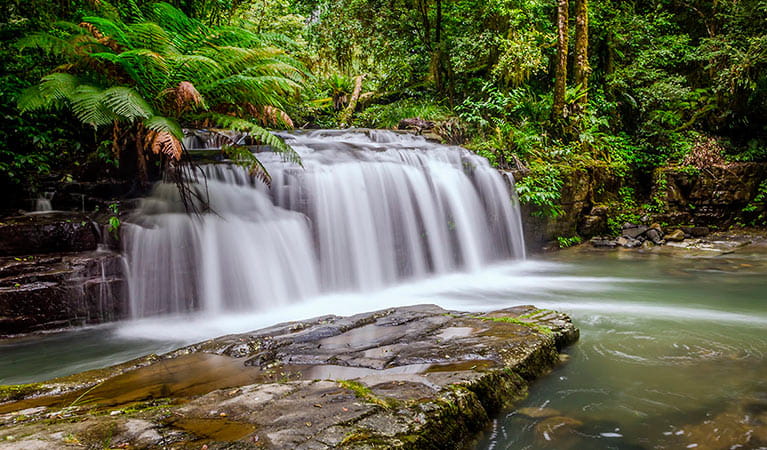
The rainforests in Barrington Tops National Park are part of the Gondwana Rainforests of Australia World Heritage Area; the most extensive strip of diverse rainforest anywhere on earth. The World Heritage Area is a direct window into the past and the future, providing a link to the ancient pre-human world and a stunning and irreplaceable record of life on our planet. You can explore the rainforest on one of the park's many walking tracks, like the Honeysuckle Forest track, the Rocky Crossing walk or the Antarctic Beech Forest track. Listen out for the lyrebird whose mimicking calls ring out through the rainforest.
- Antarctic Beech Forest walking track Antarctic Beech Forest walking track offers rainforest, cascades, scenic views, and birdwatching in Barrington Tops National Park, near Gloucester.
- Careys Peak walking track Easy Careys Peak walking track offers picnicking, scenic views, birdwatching, and historic heritage in the sub-alpine region of Barrington National Park, near Scone.
- Cobark Park picnic area Take a break at Cobark Park picnic area to plan your adventures in the plateau region of Barrington Tops National Park—1 hour from Gloucester.
An ancient landscape
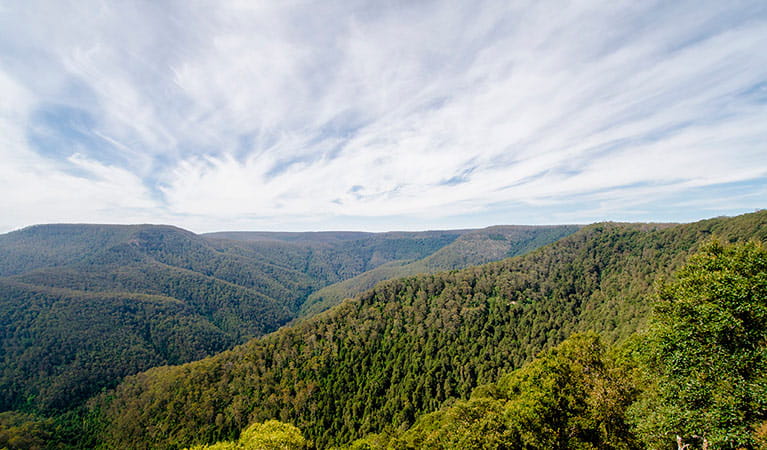
Barrington Tops National Park and the adjoining State Conservation Area are the traditional land of several Aboriginal groups, including the Worimi and Biripi people, the Gringai clan of the Worimi people and Wonnarua people. The rainforests of Barrington Tops offered a wealth of resources for Aboriginal people, including many edible fruits, like the native cherry, lilly pilly and figs. Today, the history of Aboriginal people in Barrington Tops is recorded in oral history and in the presence of Aboriginal sites. Barrington Tops National Park protects ancient campsites, scarred trees and sacred ceremonial places.
A dramatic wilderness
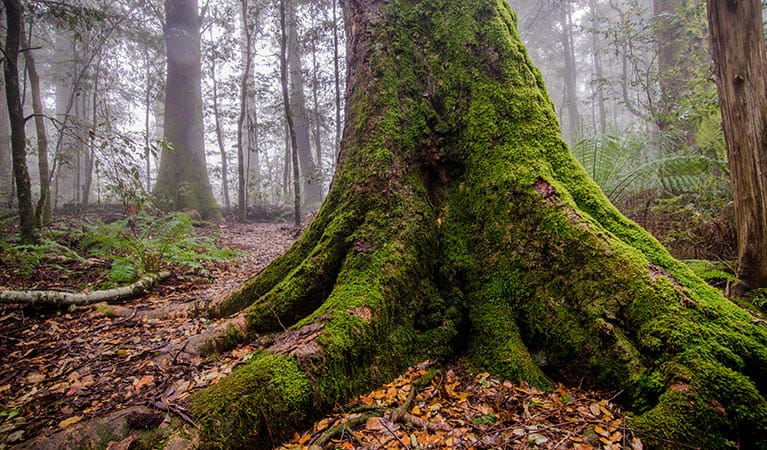
Most of Barrington Tops National Park is declared wilderness; large, natural areas of land that, together with their native plants and animal communities, remain essentially unchanged by modern human activity. Wilderness areas in NSW represent the largest, most pristine natural areas within NSW - the last of Australia's wild and untamed places. The edges of the wilderness area of Barrington Tops are easily accessible; some of the most spectacular views in the park are from Careys Peak and Devils Hole and Thunderbolts lookouts. You'll notice the varied textures of the forest below you, with the ranges of the Barrington Wilderness running east and south from the plateau like the fingers of an outstretched hand.
- Barrington Tops and beyond tag-a-long 4WD tour Get off the beaten track with As the Crow Flies 4WD Tours for an exciting tag-along adventure in Barrington Tops National Park, near Gloucester.
- Barrington trail Take the challenge of the Barrington trail, a 4WD trail in Barrington Tops National Park. Open between October and May every year, plan your 4WD camping holiday now.
- Gloucester Tops circuit Walk through snow gum woodland and ancient rainforest to lookouts and waterfalls, along the Gloucester Tops circuit. This 8km loop combines 3 popular and scenic walks in Barrington Tops National Park.
- Majestic Barrington mountain bike tours Enjoy spectacular scenery as you cycle through Barrington Tops National Park and beyond on this supported mountain bike tour with Aussie Bike or Hike, near Gloucester.
- Rocky Crossing walk Rocky Crossing walk along Williams River offers scenic rainforest views, wildlife and birdwatching on a long easy track in Barrington Tops National Park, near Dungog.
Plants and animals protected in this park
Animals
-

Superb lyrebird (Menura novaehollandiae)
With a complex mimicking call and an elaborate courtship dance to match, the superb lyrebird is one of the most spectacular Australian animals. A bird watching must-see, the superb lyrebird can be found in rainforests and wet woodlands across eastern NSW and Victoria.
-

Swamp wallaby (Wallabia bicolor)
The swamp wallaby, also known as the black wallaby or black pademelon, lives in the dense understorey of rainforests, woodlands and dry sclerophyll forest along eastern Australia. This unique Australian macropod has a dark black-grey coat with a distinctive light-coloured cheek stripe.
-

Bare-nosed wombat (Vombatus ursinus)
A large, squat marsupial, the Australian bare-nosed wombat is a burrowing mammal found in coastal forests and mountain ranges across NSW and Victoria. The only other remaining species of wombat in NSW, the endangered southern hairy-nosed wombat, was considered extinct until relatively recently.
-
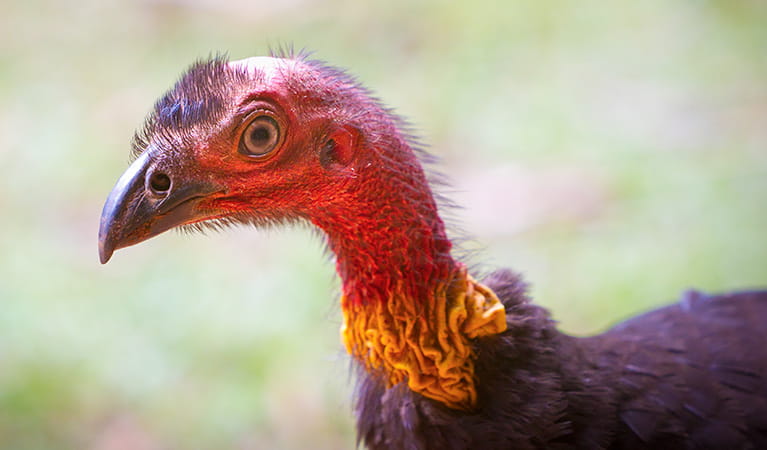
Australian brush turkey (Alectura lathami)
The Australian brush turkey, also known as bush or scrub turkey, can be found in rainforests along eastern NSW. With a striking red head, blue-black plumage and booming call, these distinctive Australian birds are easy to spot while bird watching in several NSW national parks.
-

Common ringtail possum (Pseudocheirus peregrinus)
Commonly found in forests, woodlands and leafy gardens across eastern NSW, the Australian ringtail possum is a tree-dwelling marsupial. With a powerful tail perfectly adapted to grasp objects, it forages in trees for eucalypt leaves, flowers and fruit.
-
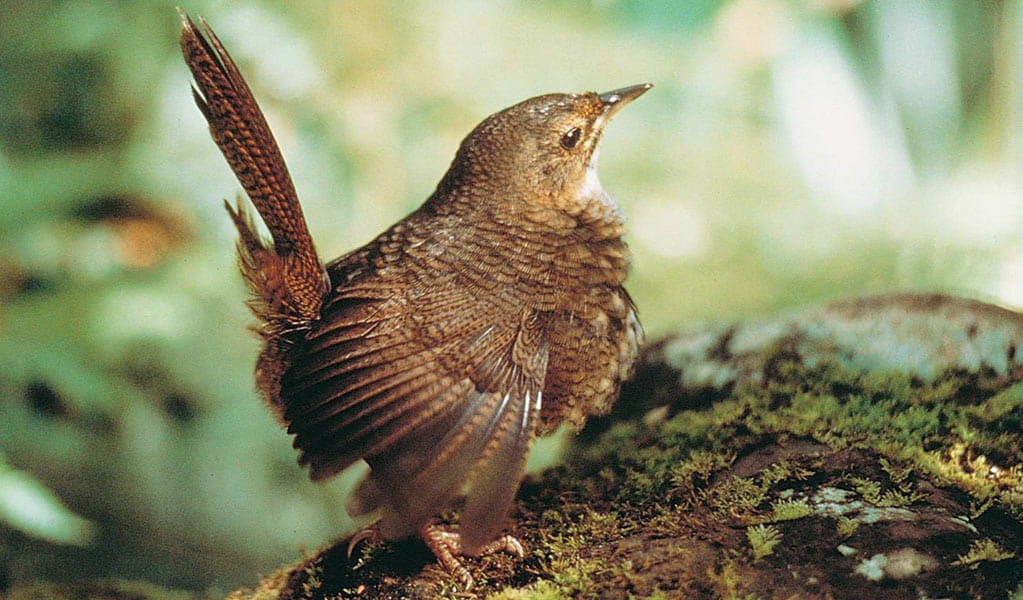
Rufous scrub-bird (Atrichornis rufescens)
The vulnerable rufous scrub-bird is a small, ground-foraging bird that lives only in isolated rainforest areas of south-eastern Australia.

